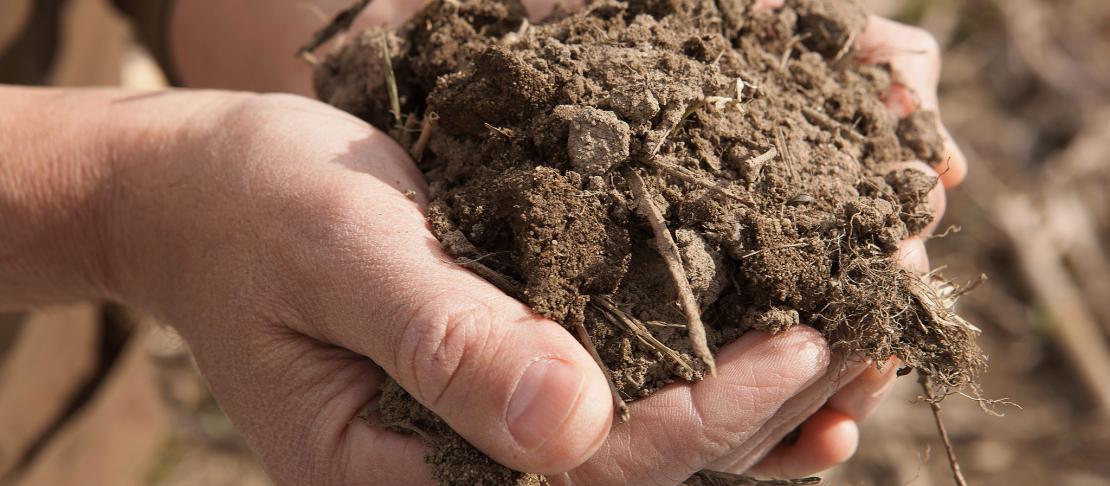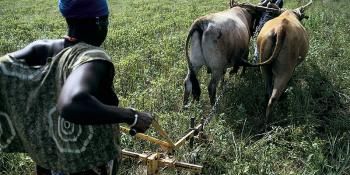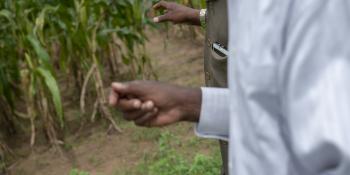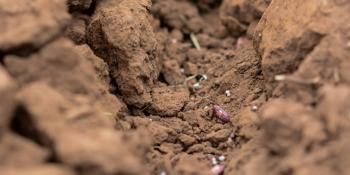Soil organic carbon: a call to action on World Soil Day

We know that managing soil organic carbon can help mitigate climate change and support food production. The challenge is whether actions can be taken at large enough scales and quickly enough to matter.
In a commentary published in Nature this week, scientists advising the “4 per 1000 Initiative: Soils for Food Security and Climate” called for action to enable large-scale management of soil carbon. They recommended increasing global soil carbon by protecting existing carbon in peatlands and forests, restoring degraded lands, and supporting farmers to use best practices on current agricultural lands.
To achieve global impact, the authors called for a joint forum to coordinate action and funding of:
- Improved methods to track and evaluate interventions with science-based harmonized protocols and standards, including high-tech remote sensing and other spectroscopy tools for faster, cheaper and more accurate monitoring of soil carbon changes.
- Improved understanding of what works under different local conditions, using modelling and a global network of field sites. An open data platform would enable wide, rapid information-sharing.
- Policies on soil and climate in the United Nations Framework Convention on Climate Change (UNFCCC) and at the national level to provide technical assistance and incentives to farmers and monitoring systems to track and validate progress.
The science and the policy of soil carbon are particularly relevant this week, as the UNFCCC meets in Katowice, Poland (COP24) and the Koronivia Joint Work on Agriculture (KJWA) plans for how the UNFCCC should address climate action in agriculture. And in June 2019 the KJWA will hold a workshop addressing soil carbon. The state of knowledge about what is possible therefore matters.
Increasing soil organic carbon stocks at large scales
The launch of the 4p1000 Initiative in 2015 launched a healthy debate about the potential climate change mitigation that can be achieved with soil carbon. While most scientists agree that the potential impacts of soil carbon are significant, the science is still emerging, as noted in special sessions on soil carbon at the GRA-JPI-CCAFS Science-Policy Dialog in Berlin September 10-13 and at the 5th International Rice Congress October 14-17 in Singapore, as well as in recent publications. For example, Blakemore (2018) claims that a lack of consideration of topography, in determining the earth’s land area, has led to vast underestimates of soil organic carbon storage of up to 4 to 6 times, raising questions of what other basic assumptions remain to be challenged.
In particular, we need to determine the pace of change possible in the near-term and the extent of interventions needed to avoid a 2° increase in global temperature by 2100. Challenges to achieving large-scale carbon sequestration include nutrient limits, inadequate farmer incentives and competition for, or a lack of, organic matter inputs in some places.
Recent CGIAR research on soil organic carbon on agricultural lands
Research is helping to target priorities for action. Zomer et al. (2017) analyzed the potential for global soil organic carbon increases through better management of cropland. They show that the amount of carbon in the top 30 centimeters of soil globally could gain an extra 0.9 to 1.85 gigatons each year, or 0.56 to 1.15 tons of carbon per hectare per year for a 20-year period by better managing cropland soils. Temperate regions have the highest potential for storing carbon in croplands, especially the United States, followed by India, China, Russia and Australia. Tropical croplands have a lower potential for storing carbon but most desperately require improved productivity to meet food security needs. This raises a debate about where to allocate resources.
Agronomic trials remain important to identify best practices for local conditions, but these results need to be scaled up to understand their implications for national mitigation goals. Sapkota et al. (2017) tested tillage strategies for rice-wheat systems of northwest India. They found that zero tillage and retention of crop residues increased the soil organic carbon content by 4.66 t per hectare over 7 years. Compared to business-as-usual, this system increased soil organic carbon content by 0.8 t per ha per year. Sapkota et al. (2018) then showed how adoption of zero-tillage in major crops such as rice, wheat, maize, cotton and sugarcane could offer mitigation of about 15 million tCO2e in India through carbon sequestration and reduced fossil fuel consumption.
Modeling can also help demonstrate impacts. In Ethiopia, Woolf et al. (2018) predicted that soil and water conservation, cropping practices and agroforestry could sequester about 5 tons soil organic carbon per hectare over a 20-year period.
Yet making decisions about where to invest in soil carbon and validating soil carbon increases remains problematic. Gains vary from year to year, and they are easily reversible. The key is getting carbon into long-term storage pools, which takes time. Because this is a much slower process than simply increasing total soil organic matter, it is more difficult to detect changes.
Wironen (2018) assessed how multilateral development banks made decisions about investing in soil organic carbon-enhancing measures. He concluded that many of the preferred simple decision-making methods such as “practice lists” are limited by scientific uncertainty and context-dependence. Investing in some measurement, such as in the approach used by the Australian Emissions Reduction Fund, would significantly reduce uncertainties, albeit at a potential cost tradeoff.
Trade-offs can also occur. With respect to peatlands, Hergoualc’h et al. (2018) recommend that a variety of wetland-adapted livelihoods and financially viable agro-business options be urgently developed to address complex tradeoffs between environmental and economic objectives. Cross-sectoral, transparent dialogue among stakeholders and rigorous analysis of the impacts of alternatives should inform decisions about trade-offs.
Action now!
To achieve ambitious results will require ambitious action, including actions to learn what is really possible and how to manage soil carbon better. Even if the impacts are less that what has been predicted in recent years, actions at any scale will still benefit the climate and food security.
Read more
- Article: 4P1000 science and technical committee led by Rumpel. 2018. Put more carbon in soils to meet Paris climate pledges. Nature.
- Article: Blakemore. 2018. Non-flat earth recalibrated for terrain and topsoil. Soil Systems.
- Brief: Hergoualc’h et al. 2018. Managing peatlands in Indonesia: Challenges and opportunities for local and global communities.
- Article: Sapkota et al. 2017. Soil organic carbon changes after seven years of conservation agriculture in a rice–wheat system of the eastern Indo‐Gangetic Plains. Soil Use and Management.
- Article: Sapkota et al. 2018. Cost-effective opportunities for climate change mitigation in Indian agriculture. Science of the Total Environment.
- Article: Sommer and Bossio. 2014. Dynamics and climate change mitigation potential of soil organic carbon sequestration. Journal of Environmental Management.
- Info note: Wironen. 2018.Decision support for agricultural soil carbon sequestration: Multi-lateral development banks’ needs and challenges.
- Article: Woolf et al. 2018. Land restoration in food security programmes: synergies with climate change mitigation. Climate Policy.
- Article: Zomer et al. 2017. Global sequestration potential of increased organic carbon in cropland soils. Nature Scientific Reports.
Lini Wollenberg is Flagship Leader, Low Emissions Development at CCAFS. Lou Verchot is Director, Soils Research Area at the International Center for Tropical Agriculture (CIAT).
World Soil Day (WSD) is held annually on 5 December as a means to focus attention on the importance of healthy soil and advocating for the sustainable management of soil resources.




